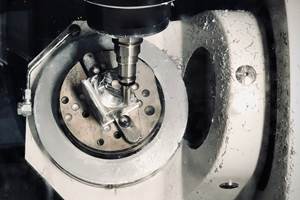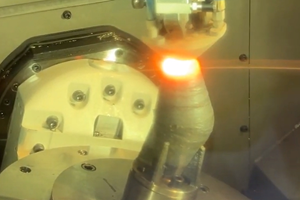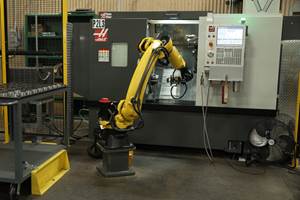Vertical Machining Center Cuts Production Time At Mold Maker
Every good business plan must contain a number of specific goals, not the least of which includes experienced, professional workers with the necessary tools to get their jobs done right. But turning goals that are written on a piece of paper into reality is easier said than done. That's why J M Mold South developed a specific partnership. The company services the needs of plastic and die cast molders, builds new molds and repairs existing molds.
Share






Every good business plan must contain a number of specific goals, not the least of which includes experienced, professional workers with the necessary tools to get their jobs done right. But turning goals that are written on a piece of paper into reality is easier said than done. That's why J M Mold South developed a specific partnership. J M Mold South (Easley, South Carolina) is a branch of J M Mold (Piqua, Ohio). The company services the needs of plastic and die cast molders, builds new molds and repairs existing molds.
The partnership part of J M Mold South President Dave Bowers' business plan involves finding a labor force. The community's skilled workers did not have the special skills needed by mold makers. So, Mr. Bowers paired up with local vocational schools to help craft the curriculum and gain a better knowledge of the talent available. Education also seemed to be the key to unlocking the second piece of the business plan puzzle. Mr. Bowers knew that the employees would be more productive if J M Mold South purchased the appropriate machinery. He spent several months studying the technology, reading articles in trade publications, and visiting machine tool builders to better understand their offerings.
One of the major areas Mr. Bowers explored was the issue of CAD operations and data file transmission. Due to an increasing customer demand for high quality and shorter leadtimes, J M Mold South made significant investments in CAD/CAM software (Pro/E) and hardware including Local Area Networks (LAN). This permitted J M Mold to play a much-improved "consulting" role with not only the molders, but directly with the part designers. This helped improve mold design features and reduced communication turnaround time.
In the mid-90s, J M Mold South purchased an advanced Mitsubishi horizontal machining center to do mold bases and plates. The company immediately generated a cost saving over the machining centers it had been using. Its next purchase was a Mitsubishi CNC diesinker. Once again, productivity of core and cavity work rose, and delivery times were reduced.
The machine became so productive, a new bottleneck emerged—electrode production. Now, J M Mold South needed technology to solve this electrode production problem. The company decided it needed to purchase a vertical machining center. With the advances in control, servodrive, and software technology, a Hurco BMC 2416 vertical machining center from Hurco Machine Tool Products (Indianapolis, Indiana) was its choice.
The new Hurco played a role in managing the high-integrity part surface data that was being generated by J M Mold South's CAD/CAM system. Hurco's BMC 2416 is equipped with the Ultimax control, which handled the large programs (10 to 20 megabytes). "Generally, what might have taken up to six or eight hours before the Hurco has been reduced to a 40-second operation," Mr. Bowers says.
Hurco was able to provide J M Mold South with a powerful Pentium-based, open architecture control with full 1,000-block-per-second processing speed, advanced performance AC servodrives and motors from Yaskawa, large RAM (40 megabytes) and a 1.7-gigabyte hard drive.
Also, the Hurco machine provided advanced feed rate velocity and acceleration algorithms that, coupled with continuous, infinite data block look-ahead, generate precise control such that feed rates can be maximized with "Net Shape Machining." This makes toolmark- and gouge-free machining a reality.
This combination of control software and servo technology produced improvements in electrode machining times. Savings of 30, 50 and even 70 percent occurred on every job. Part accuracy was excellent, which reduced EDM processing time and mold cavity benchwork. No destructive part gouging or overruns occur, so quality parts are the norm. By linking into its PC LAN, J M Mold South reduced file transfer time to seconds with no data loss. With the Hurco machine's large memory, there is never data starvation during a run. Ultimately, what once took two conventional CNC vertical machining centers to do is now accomplished by one Hurco. Plus, the Hurco still has 20 percent of its available time open for other work.
Mr. Bowers is pleased with the results. "The bottom line is that our leadtime has been decreased," he says. "Our competitors generally offer a standard 16-week delivery time on parts. We are now able to complete the same kinds of projects in 12 to 14 weeks. That gives us a two- to four-week advantage over our competitors." Ultimately, while the front-end of technology is not cheap, the operational gains generate payback in months, not years, and continue to drive the business forward.
Related Content
Lean Approach to Automated Machine Tending Delivers Quicker Paths to Success
Almost any shop can automate at least some of its production, even in low-volume, high-mix applications. The key to getting started is finding the simplest solutions that fit your requirements. It helps to work with an automation partner that understands your needs.
Read MoreHow to Successfully Adopt Five-Axis Machining
While there are many changes to adopt when moving to five-axis, they all compliment the overall goal of better parts through less operations.
Read MoreAdditive/Subtractive Hybrid CNC Machine Tools Continue to Make Gains (Includes Video)
The hybrid machine tool is an idea that continues to advance. Two important developments of recent years expand the possibilities for this platform.
Read MoreWhich Approach to Automation Fits Your CNC Machine Tool?
Choosing the right automation to pair with a CNC machine tool cell means weighing various factors, as this fabrication business has learned well.
Read MoreRead Next
Machine Shop MBA
Making Chips and Modern Machine Shop are teaming up for a new podcast series called Machine Shop MBA—designed to help manufacturers measure their success against the industry’s best. Through the lens of the Top Shops benchmarking program, the series explores the KPIs that set high-performing shops apart, from machine utilization and first-pass yield to employee engagement and revenue per employee.
Read MoreAMRs Are Moving Into Manufacturing: 4 Considerations for Implementation
AMRs can provide a flexible, easy-to-use automation platform so long as manufacturers choose a suitable task and prepare their facilities.
Read More



















